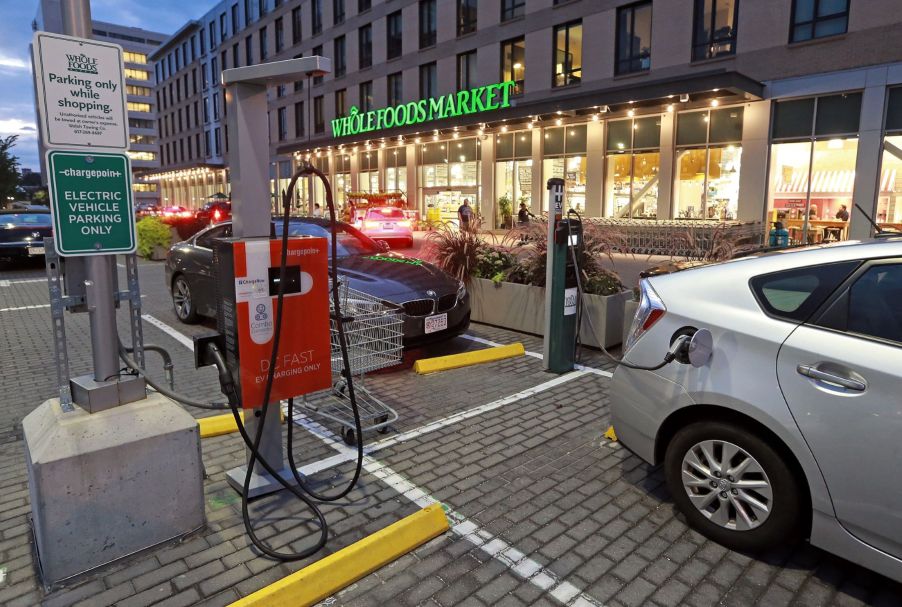
How Much Does It Cost to Charge an Electric Car at Whole Foods?
Electric vehicles (EVs) are convenient due to their low maintenance costs. Many businesses are embracing the shift in the automotive market by offering EV charging stations. Whole Foods Market is among the brands providing these facilities to employees and customers. When shopping at your local Whole Foods outlet, you can likely charge your electric car at an affordable cost. So, how does it cost to charge an EV at a Whole Foods?
Differences between electric car charging levels
According to the U.S. Department of Transportation, you can charge an EV using Level 1, 2, and 3 charging methods. Level 1 charging equipment uses a standard 120-Volt AC outlet. Such outlets are common in residential areas. A Level 1 charger can take 40-50 hours to charge a battery electric vehicle (BEV) to 100% from empty. However, you only need 5-6 hours to fully charge a plug-in hybrid electric vehicle (PHEV).
Level 2 charging equipment uses 240V or 208V outlets. Per NeoCharge, you may need 6-12 hours to charge your EV, depending on its battery. Like Level 1 equipment, Level 2 is most commonly found near businesses, but you can upgrade a standard outlet into a Level 2 charging station in your garage if you’re willing to pay for the expense.
Level 3, or direct current fast charging (DCFC), is the fastest type. Unlike Level 1 and 2 equipment, this type doesn’t use alternating current (AC). Instead, it relies on a direct current of over 480V. Level 3 charging equipment is primarily available in commercial stations like Whole Foods.
Tesla Superchargers are a form of Level 3 charging equipment. According to EV Town, you can charge your battery halfway within 20 minutes. Tesla Superchargers come in two types, V2 and V3.
V3 stations deliver more until the 60% state of charging as reported by Inside EVs. On the other hand, a V2 station provides less power, but the difference isn’t significant. V3 equipment will take 63.5 minutes to charge from 0 to 100%, while a V2 supercharger requires 1 hour and 10 minutes.
The cost of charging your electric vehicle at Whole Foods

There isn’t a specific fee for charging your EV at Whole Foods. Most stations at the parking areas charge different rates, often set by the store. Depending on the station you use, you can enjoy discounts provided you have a subscription with the service provider.
Whole Foods charges a flat fee of $0.99 for using CHAdeMO charging ports provided by EVgo. Depending on the time of day, you then pay a varying rate of $0.39-$0.59 per kWh. When using the J1772 COMBO ports, you will incur similar rates. Still, you might pay a lower amount depending on your EVgo membership plan.
Blink Charging is among the top providers of public EV charging equipment. The company partnered with Whole Foods to provide much-needed amenities for EV customers. You will incur $0.45/kWh when using Blink’s Level 2 charging stations at Whole Foods, provided you have a membership. If you are a guest, you will pay $0.55/kWh.
Whole Foods is adding more EV charging stations
While Whole Foods set up EV charging stations to benefit the public, issues arose quickly. The chain’s parking lots became ground zero in the charging wars due to high demand, per EnergyWire. Customers often rushed to the areas only to find the ports booked half the time.
This raised concerns with more clients asking the store to increase EV charging stations’ availability. Whole Foods responded to customers’ needs by improving its amenities. The store has deployed more charging stations through a partnership with Blink Charging.
The initial stations were at Whole Foods branches in Spring House, Lancaster, and Exton, Pennsylvania. However, the store has launched more locations with EV charging in different states. This measure emphasizes Whole Foods’ commitment to premium customer service and sustainability.
If you want to charge your car at Whole Foods, you can find nearby stations using a map app like PlugShare. Such a tool will highlight EV charging areas using your phone’s location. It will also provide vital information like the rates charged by each station.



